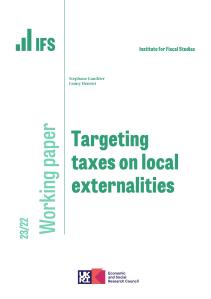This paper uses a realistic structural lifecycle model of consumption and housing decisions to understand how data might distinguish different mechanisms that explain the correlation between house prices and consumption. The model includes price and earnings shocks estimated from data (the latter including aggregate and idiosyncratic components), and incorporates realistic features of the UK mortgage market. We simulate the model using more than 30 years of realized shocks and under counterfactual scenarios. Our results confirm the intuition of earlier studies: house price shocks should have a larger effect on the consumption of older households and earnings shocks on young households.
Authors

Research Associate University of Bologna
Matthew is Associate Professor at the University of Bologna focusing on consumption and savings choices and how policy affects them.

CPP Co-Director
Orazio is an International Research Fellow at the IFS, a Professor at Yale and a Research Associate at the National Bureau of Economic Research.

Andrew Leicester
Journal article details
- Publisher
- Wiley
- JEL
- D91; E21
- Issue
- June 2011
Suggested citation
O, Attanasio and A, Leicester and M, Wakefield. (2011). 'Do house prices drive consumption growth? The coincident cycles of house prices and consumption in the UK' (2011)
More from IFS
Understand this issue

What's wrong with inflation?
10 May 2023

Transparency is key to maintaining trust in government. Let’s not cap it
12 September 2022

How should the government tax electric cars?
19 May 2022
Policy analysis

Tax and public finances: the fundamentals
23 August 2023

Poverty
13 July 2023

Living standards, poverty and inequality in the UK: 2023
13 July 2023
Academic research

Saving by buying ahead: stockpiling in response to lump-sum payments
2 February 2024

Adverse selection among early adopters and unraveling innovation
18 December 2023

Targeting taxes on local externalities
14 August 2023